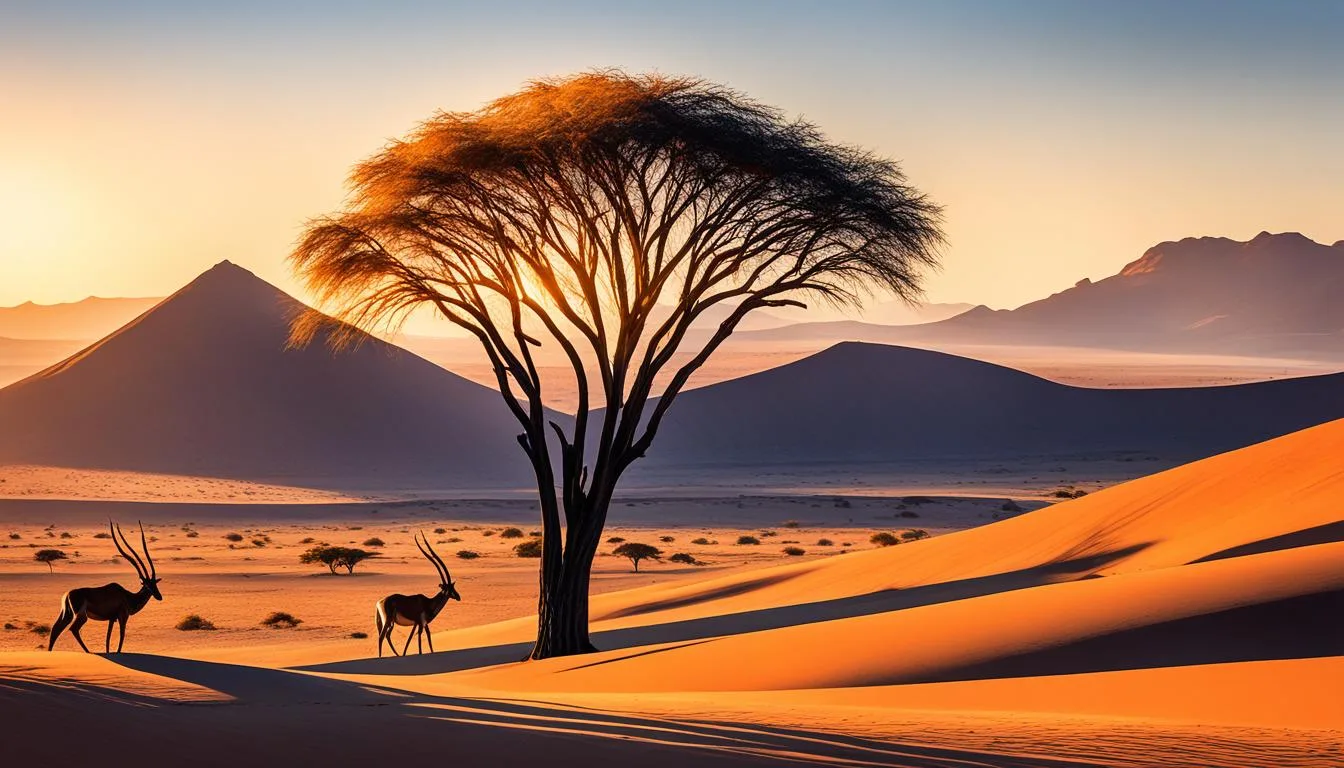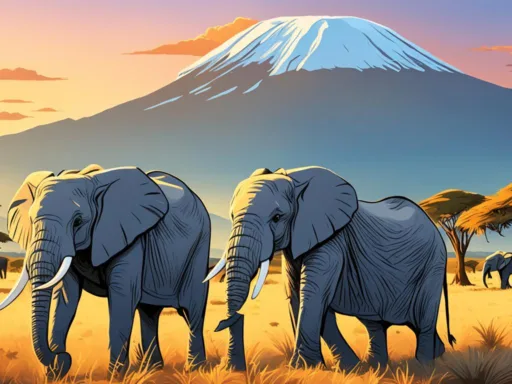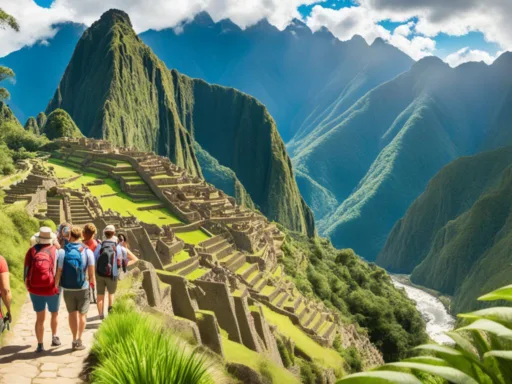Have you ever wondered which months reveal Namibia’s untamed wildlife and majestic deserts in all their glory? Straddling the Tropic of Capricorn, this African jewel offers a symphony of natural spectacles, but timing your visit can dramatically influence your experience. This journey through the Best Time to Visit Namibia is not just about sunny skies and comfortable temperatures; it’s about synchronizing with nature’s rhythms. Let’s uncover the secrets of the Namibia travel seasons and find out precisely When to go to Namibia to witness its landscapes and wildlife at their peak.
Key Takeaways
- Discover the peak wildlife spotting months from late June to October in renowned locales like Etosha National Park.
- Find out why from late September to March/April is the birdwatcher’s paradise in Namibia.
- Learn about the challenges of daytime travel during the December to March rainy season and its effect on landscape accessibility.
- Gain insight into the cooler winter period stretching from May to September and its advantages for desert exploration.
- Understand how the coastal fog phenomena along Namibia’s Skeleton Coast can influence your travel experience.
Navigating Namibia’s Climate: A Weather Guide for Travelers
For those plotting a journey to the vast expanse of Namibia, understanding the local climate is essential for a trip that’s as awe-inspiring as it is comfortable. Whether you’re a wildlife aficionado, a landscape photographer, or simply an adventure-seeker, the ideal time to travel Namibia varies, making a comprehensive Namibia weather guide indispensable.
The Dry Season in Namibia: April to October
During the dry months, Namibia transforms into a vast theatre of clear skies and expansive horizons. While the land may thirst for rain, visitors benefit from those dry conditions, especially when it comes to exploring the natural world. From April to October, Namibia’s tourist seasons witness incredible wildlife spotting opportunities, as animals cluster around the scarce waterholes, creating a unique tableau of African fauna.
Understanding the Rainy Season: November to March
Conversely, the rains from November to March cloak the country in hues of green, with fresh sprouts piercing the once-dry soil. This period might challenge game viewing prospects, yet it compensates with a flourish of avian life, attracting birdwatchers worldwide during these vibrant Namibia tourist seasons.
Temperature Fluctuations: From Hot Days to Chilly Nights
Packing for a country known for its arid landscapes means preparing for the extremes. The searing heat of daytime can surge to 40°C, notably from October to April, making early mornings and late afternoons the preferred times for outdoor activities. Once the sun sets, the desert cools rapidly, rewarding travelers with refreshingly cold evenings and nights, especially in the heart of the winter months.
Whether it’s the parched beauty of the dry season or the lush allure of the rainy months, Namibia offers an array of experiences against the backdrop of its distinctive weather patterns.
Best Time to Visit Namibia: Wildlife Watching and Game Drives
When it comes to planning that picture-perfect safari, timing is everything. In Namibia, the peak season coincides with the southern hemisphere’s winter months. Extending from July to October, this period promises an ideal climate for wildlife watching and taking memorable game drives across its diverse landscapes.
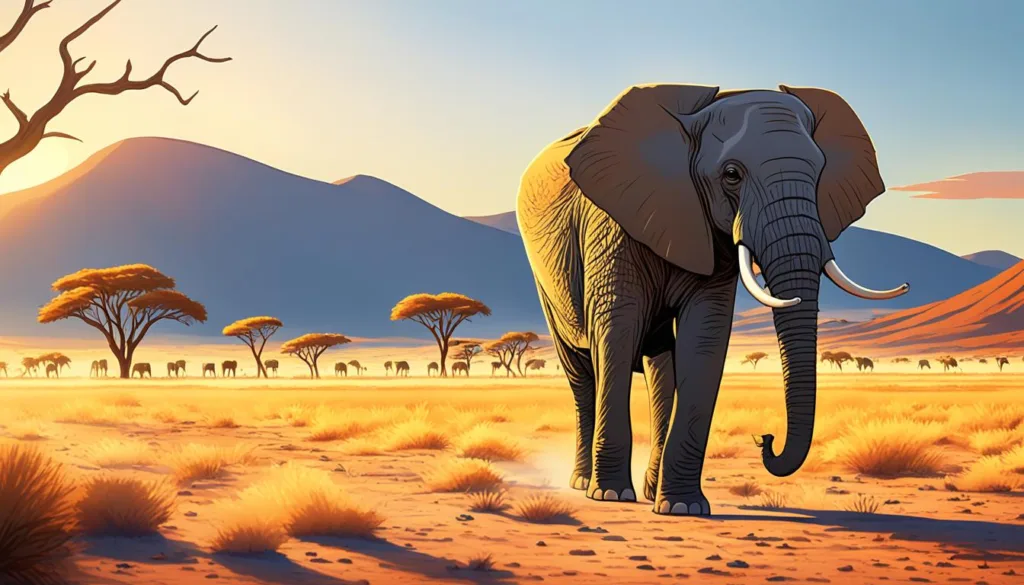
With temperatures hovering just above a comfortable 70°F and scarce rainfall, the conditions during these months are incredibly favorable for observing the tapestry of Namibia’s animal kingdom. Whether it’s the elephants by the waterholes or the lions tracking gazelle through the savannahs, these are precious moments you won’t want to miss.
Moreover, with off-peak travel dates in Namibia, visitors have a unique opportunity to witness the country’s natural beauty. October not only brings wildlife to the forefront but also paints the landscape in vibrant hues with the bloom of jacarandas. It is indeed the Best Time to Visit Namibia for both serene sceneries and exciting animal encounters.
| Month | Activity | Wildlife Events | Climate Note |
|---|---|---|---|
| July – August | Game Drives & Photography | Increased wildlife visibility at water sources. | Mild temperatures, making it comfortable for full-day excursions. |
| September | Bird Watching | Start of migratory birds season. | Beginnings of warmer spring weather. |
| October | Scenic Drives & Walking Tours | Jacarandas in bloom; dynamic wildlife interactions. | Seasonal transition offers warm days and cooler evenings. |
Ensure your plans are solidified in advance if you’re aiming to visit during peak season Namibia. This is when the allure of the wild calls out to nature lovers globally, leading to limited availability at lodges and campsites, especially in hotspots like Damaraland and Etosha National Park. So, mark your calendars, secure your bookings, and prepare for an enthralling encounter with Namibia’s majestic wildlife.
The Allure of Namibia’s Desert: When to Explore Iconic Landscapes
The haunting beauty of Namibia’s deserts summons adventurers from all corners of the globe. As you plan your journey to this magnificent land, understanding the Namibia travel seasons and delving into a Namibia weather guide are pivotal to ensure your adventure aligns with the best possible conditions for exploration.
Sossusvlei and Sesriem’s Majestic Dunes
At the heart of the Namib Desert, the Sossusvlei and Sesriem region captivates with its towering dunes and stark, Martian-like terrains. To fully appreciate the grandeur without the extreme heat, travelers should aim for the cooler winter months. From May to October, the climate becomes an ally to explorers; with particular emphasis on June to August, where one can ascend the dunes in the embrace of milder temperatures, making each step a notch less strenuous. For those looking to capture the perfect photo, the low angle of the winter sun bathes the sand in a palette of evolving colors, casting mesmerizing shadows – a true feast for the shutterbugs.
The Foggy Enigma of the Skeleton Coast
A visit to the Skeleton Coast – a place where the ocean meets the desert – offers an experience wrapped in mist and mystery. Known for its fog-laden mornings, this coastal stretch resides under a near-permanent overcast condition, creating an otherworldly atmosphere. Yet, the intrigue of the coast doesn’t wane once the fog lifts. Travelers here find year-round opportunities to explore this unique ecosystem; however, to maximize visibility and the overall experience, journeying when the fog is likeliest to dissipate by midday would be ideal.
In aligning your travel plans with the seasonal nuances of Namibia’s weather, you can transform a great trip into an exceptional adventure. Below is an at-a-glance guide that further details the optimal times to visit these iconic landscapes:
| Region | Best Travel Season | Weather Conditions | Travel Tips |
|---|---|---|---|
| Sossusvlei & Sesriem | May – October | Cooler, dry desert climate | Start early to avoid the midday sun; bring water! |
| Skeleton Coast | Year-round (best visibility after midday) | Foggy mornings, clearer afternoons | Layer clothing for the changing conditions |
Whether you revel in the climb of a lifetime up a sand dune or marvel at the desolate beauty of the Skeleton Coast, aligning your visit with the optimal Namibia travel seasons and heeding the advice of a comprehensive Namibia weather guide, you ensure a journey rich in memories and free from the discomforts of harsher climates.
Peak Season Highlights: July to October’s Unmissable Moments
If you’re pondering the Best Time to Visit Namibia, the period between July and October is the prime of the Namibia tourist seasons, offering more than just the promise of spectacular Wildlife Viewing. It’s a time when nature stages its most grandiose displays, and visitors can immerse themselves in the diversity and vitality of this extraordinary land.
Jacarandas in Bloom: Namibia’s Natural Spectacle
The blossoming Jacaranda trees in October herald one of the most visually stunning events in Namibia. Swathes of purple blooms frame the cityscapes, creating a vivid and enchanting atmosphere that can be enjoyed in urban settings such as Windhoek.
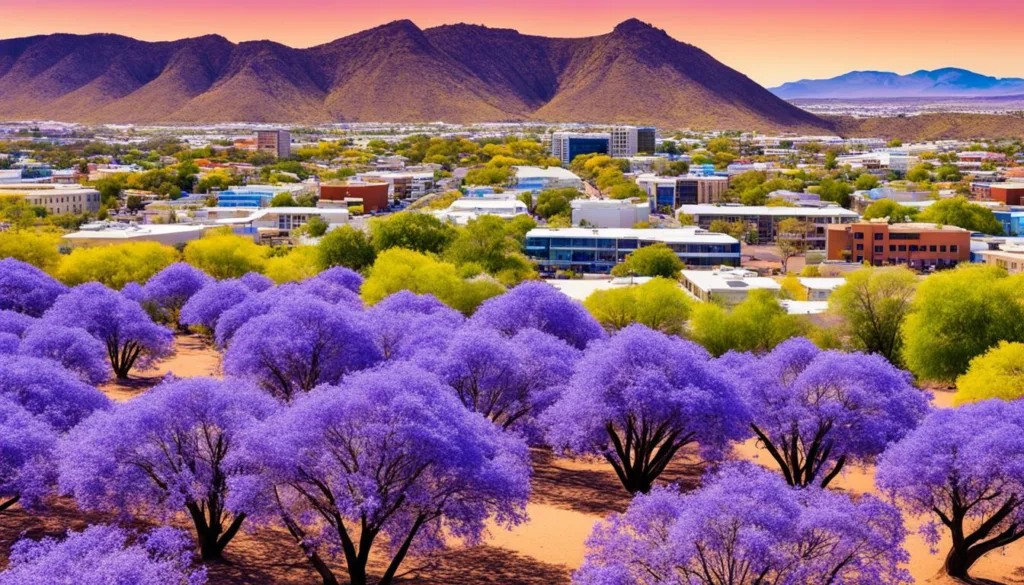
Flocking to Etosha: Dry Season Wildlife Congregations
Etosha National Park becomes a wildlife enthusiast’s haven as animals gather around the limited water sources. This convergence results in unparalleled wildlife encounters, with predators and prey interacting in a delicate balance, providing a phenomenal experience for spectators.
| Month | Wildlife Activity | Natural Phenomena | Visitor Experience |
|---|---|---|---|
| July | Beginning of significant animal congregations | Minimal | Great viewing with less crowding |
| August | Increased sightings at waterholes | Minimal | Optimally cooler temperatures |
| September | Predators more active | Start of the warmer spring period | Comfortable climate for game drives |
| October | Peak wildlife viewing as water is scarcest | Jacarandas in full bloom | Vibrant landscapes paired with dynamic wildlife scenes |
Embarking on a journey to Namibia during this peak season is truly a gateway to observing the raw beauty and drama of the African wilderness. Each month from July to October brings its own unique flavor to the adventure, making any visit within this timeframe an unforgettable chapter in your travel stories.
Off-Peak Joys: Exploring Namibia Without the Crowds
Discovering the serene beauty of Namibia during off-peak travel dates presents a unique opportunity for those looking to escape the crowds. Months such as April, May, and November offer a blend of tranquil landscapes and mild temperatures, perfect for indulging in extended excursions under the African sky. Whether you’re traversing the vast expanse of the Namib Desert or seeking a quiet moment in wildlife reserves, these shoulder months provide a sense of exclusivity without compromising on the essence of the Namibian adventure.
With the flurry of peak tourist activities subsiding, November emerges as an **ideal time to travel Namibia** for both wildlife enthusiasts and budget travelers. Lodges frequently extend favorable rates, while the environment teems with life, thanks to migratory birds enhancing the region’s rich tapestry of biodiversity. Moreover, the beauty of exploring Namibia during these times is enhanced by the balance between enjoying the great outdoors and taking advantage of the usually quiet, less populated destinations.
Perhaps one of the most captivating times for ornithophiles is February, when the stark white pans of Etosha National Park become a playground for flocks of flamingos. These months not only cater to the avian afficionado but also to any traveler drawn to the allure of the Namibian landscape, away from the wave of peak season tourism. When considering **Namibia travel seasons**, embracing the charm of the shoulder periods undoubtedly yields a memorable and immersive journey into this exquisite country nestled in the heart of southern Africa.
Off-Peak Joys: Exploring Namibia Without the Crowds
What is the best time to visit Namibia?
The best time to visit Namibia for optimal desert landscapes and wildlife viewing is between late June and October, during the dry season when the weather is cooler, and the game congregates around waterholes.
What can travelers expect during Namibia’s dry season?
Between April to October, Namibia experiences its dry season, which is characterized by clear skies, minimal rainfall, and cooler nighttime temperatures, making it an excellent period for game viewing and desert exploration.
What are the characteristics of Namibia’s rainy season?
The rainy season in Namibia spans from November to March. This time is marked by sporadic heavy rains that can lead to lush landscapes and the arrival of migratory bird species, though it can be challenging for certain types of travel due to potential flooding.
How do temperatures fluctuate in Namibia?
Namibia typically experiences significant temperature fluctuations, with daytime conditions often being very hot, especially from October to April, while nights can drop to cooler temperatures throughout the year, particularly during the winter months.
When is the peak season for wildlife watching and game drives in Namibia?
The peak season for wildlife watching and game drives in Namibia is during the dry season from July to October. This period offers the most favorable conditions for seeing a wide variety of animals as they gather at the waterholes.
What is the ideal time for exploring the dunes of Sossusvlei and Sesriem?
The cooler winter months from May to October are perfect for climbing the dunes and exploring Sossusvlei and Sesriem, with the temperatures being more moderate, specifically from June to August.
Can the Skeleton Coast be visited year-round?
Yes, the Skeleton Coast can be experienced at any time of the year. Although it’s often foggy in the mornings, the fog typically clears up around midday, making it easier to explore and enjoy the unique coastal landscapes.
What is special about visiting Namibia in October?
Visiting Namibia in October is special due to the blooming of Jacaranda trees, which add striking purple hues to cities like Windhoek, enhancing the country’s natural beauty during peak game viewing season.
Why is visiting Etosha National Park particularly recommended during the dry season?
During the dry season, particularly from July to October, visiting Etosha National Park is recommended as animals are more likely to congregate around the diminishing waterholes, which increases the chances of observing diverse wildlife.
What are the benefits of traveling to Namibia during off-peak months?
Traveling to Namibia during off-peak months like April, May, and November offers the advantages of viewing lush landscapes after the rains, enjoying more moderate temperatures, experiencing fewer tourists, and often finding lower rates at lodges and camps.

